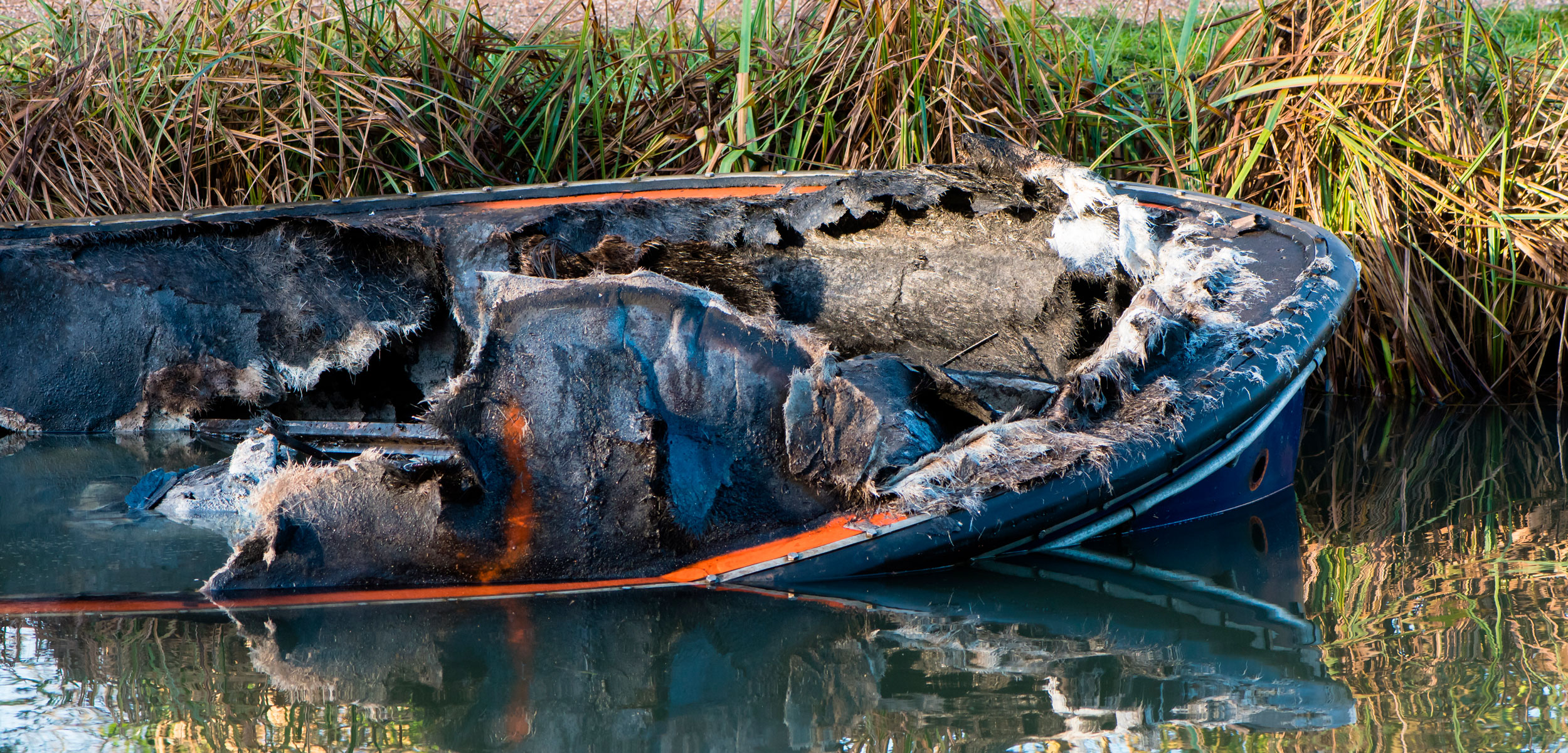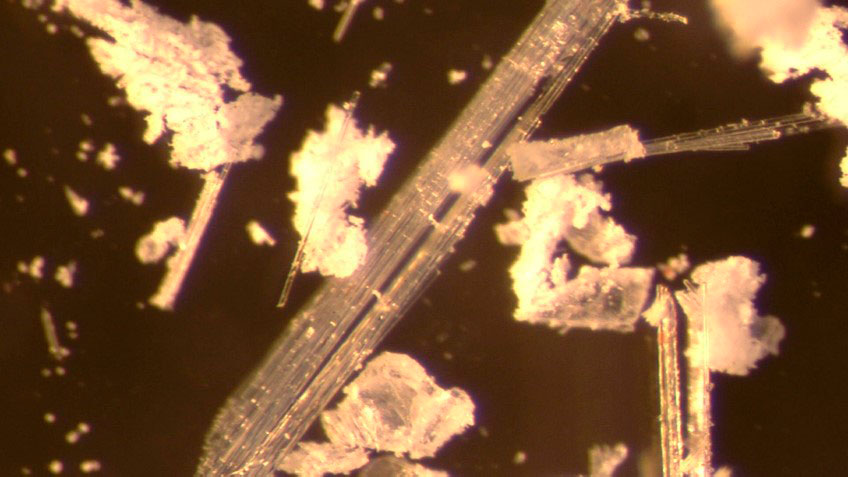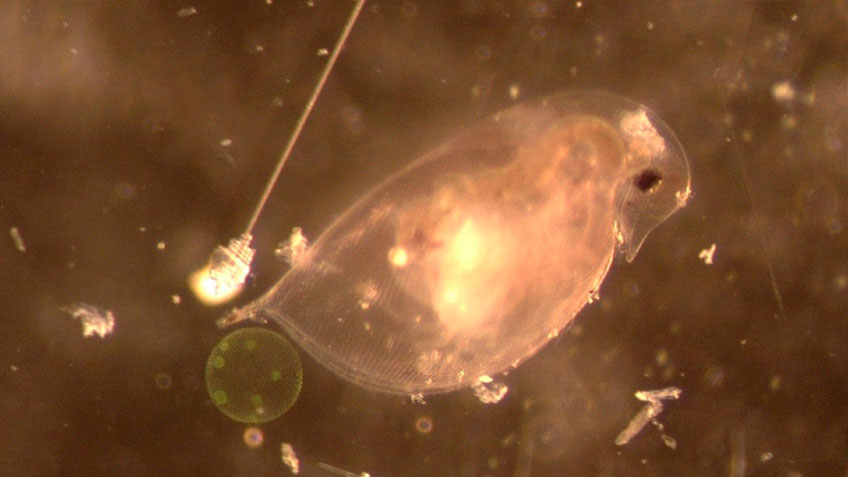The Problem with Boating’s High-Fiberglass Diet
Fiberglass revolutionized boating, but decades later, discarded and degraded vessels are adding to marine pollution. We can do something about it.
Article body copy
Oysters first alerted marine biologist Corina Ciocan to an overlooked global marine pollution crisis.
Ciocan, a marine biologist at the University of Brighton in England, has worked since 2018 on an ongoing study of plastics pollution in Chichester Harbour, an outwardly idyllic boat-dotted inlet a two-hour drive southwest of London.
Chichester waters have long supported a fishery—16th-century wooden fish traps dot the salt marsh areas of the nearby Medmerry nature reserve. Chichester itself is around 2,000 years old, with the Romans establishing the town soon after their invasion of England’s south coast. For centuries, fishers harvested oysters in abundance from the harbor, exporting them to London and mainland Europe. During one peak period of the oyster trade—the 1670s to 1720s—records show some 800,000 oysters exported in just one year. Today, the shores of Chichester’s estuary still offer a relatively undeveloped stretch of shoreline, an anomaly that the Romans would still recognize on England’s crowded southern coast. The estuary is a haven for a wide variety of sea life from crabs and lobsters to seals, as well as key aquatic plants such as kelp, which many now see as vital tools in removing carbon from the oceans. The area is a haven for avian life, too, and home to Medmerry and Pagham Harbour nature reserves, overseen by the Royal Society for the Protection of Birds, where bird lovers can see species including black-tailed godwits, little terns, and pintails.
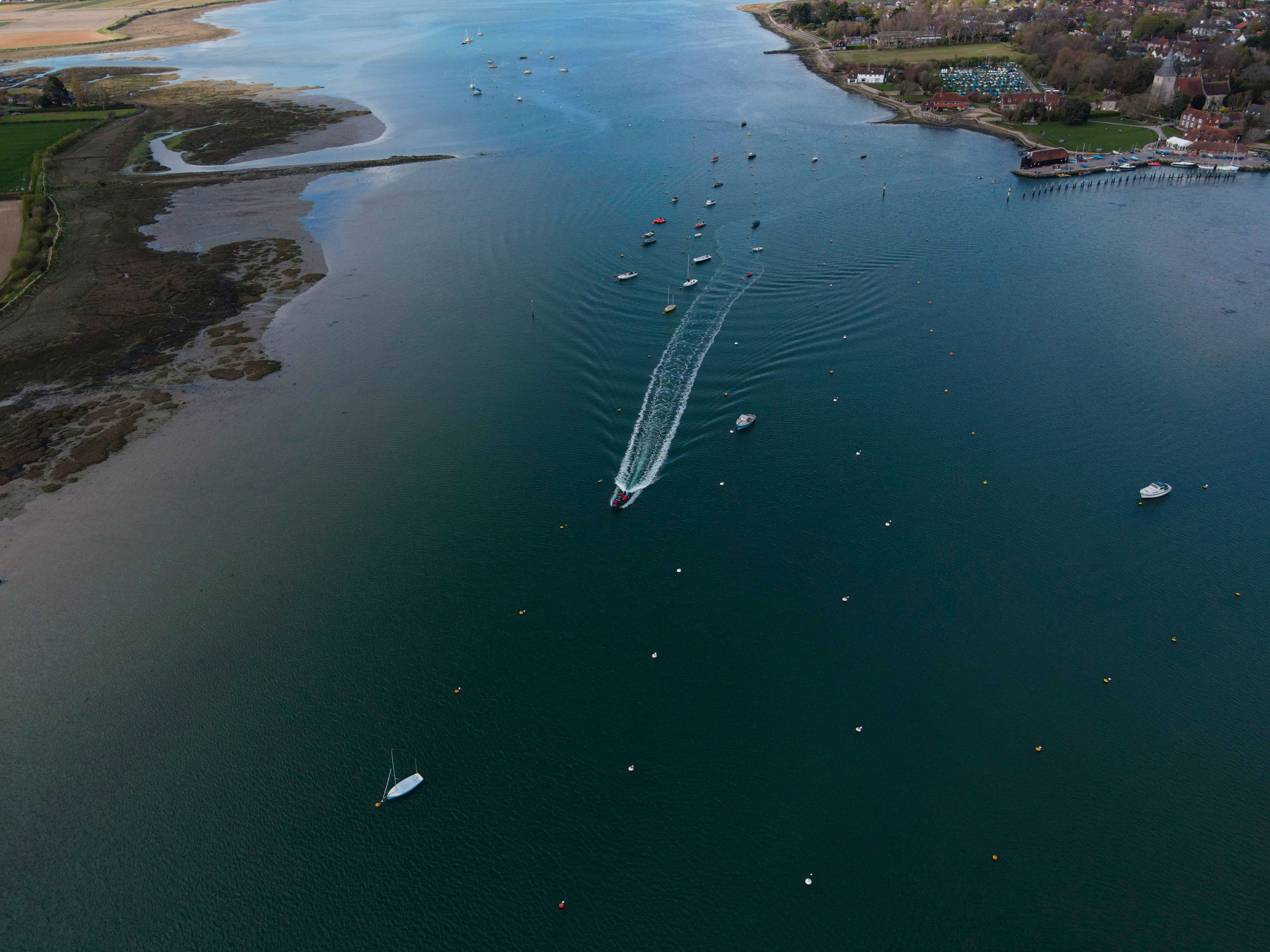
In Chichester Harbour in England, researchers have been studying the effects of boat fiberglass on oysters and other sea life. Photo by Regan Wickland/Alamy Stock Photo
Since 1971, the Chichester Harbour Conservancy has overseen the relationship between wildlife, the environment, and the human impact on the area, from sailing to fishing. Over the past decade, they noticed a steady rise in the numbers of dying oysters until a severe shortage of healthy oysters led to a fishery closure in 2018. Mystified, the conservancy contacted Ciocan.
Initially, the conservancy suspected dumped sewage and overfishing. But when Ciocan examined local shellfish, she discovered a huge number of mystery shards inside the animals, dead and alive. “We had no idea what they were,” she says. “I looked in the [scientific] literature, searched everywhere—there was absolutely no account of this in any other organism.” To identify the shards, Ciocan’s team turned to spectroscopy, a technique that analyzes the wavelengths and intensity of light emitted by a material to identify its core elements. In this way, the researchers identified yet another worrisome microplastic in oceans—fiberglass, a composite of glass and plastic.
The concentrations were staggering, with up to 7,000 tiny hairlike shards per kilogram of oyster flesh. Ciocan found the shards, which averaged around 100 microns in length and about 10 microns wide—10 times thinner than a human hair—attached to prey animals such as water fleas, too. Research has already shown that microplastics impact fish health, disrupting eating behavior, brain development, and immune systems. For human health, seafood contaminated with fiberglass is worrisome: the material is associated with a range of serious health issues, including heart and respiratory disease, as well as cancer and chronic lung disease.

Marine biologist Corina Ciocan is leading a team of researchers studying the polluting effect of fiberglass boats in Chichester Harbour. Photo courtesy of Corina Ciocan
With Chichester Harbour supporting a leisure boat fleet of around 12,000—many likely to be made from fiberglass—Ciocan’s research team and the Chichester Harbour Conservancy have no doubt that the material is coming from these boats. One avenue of contamination is the scraping and grinding of hulls in waterside boatyards when removing and repairing damaged sections of fiberglass. While not routine, this generates a significant amount of airborne dust that then drifts onto the adjacent water.
Dumped and abandoned boats are also culprits in the spread of dangerous fiberglass particles into the marine environment. Boats scrape against the sand and rocks at low tide and are degraded by the scorching sun. “It’s constant,” says Ciocan.
At her lab, Ciocan has containers full of pollutants extracted from Chichester Harbour waters and the animals that live there. When she carefully opens a sealed plastic container people might regularly use for food storage, she tells me that what looks like flour is actually a toxic mix of ground particles of fiberglass, marine paint, and antifouling material of the kind discovered escaping into the environment as a byproduct of hull maintenance work at waterside boatyards.
First photo: Ciocan’s magnified sample of fiberglass pollutants shows a combination of resin and glass. Second photo: Resin and glass surround and spear a water snail and water flea in a sample collected by Ciocan and her research team. Photos courtesy of Corina Ciocan
The problem is much broader than Chichester Harbour, and broader than fiberglass, since hulls, especially commercial vessel hulls, shed microplastics from paints. One 2021 study suggested that particles shed from hulls contributed up to 35 percent of microplastics in oceans. A study published the same year from the University of Oldenburg in Germany found that most of the plastic particles in water samples taken from the German Bight—an area in the southeast corner of the North Sea with some of the world’s busiest shipping lanes—originated from material shed by hulls, such as binders used in marine paints.
“Boats and ships are always shedding,” Ciocan says. And while things like abandoned fishing gear (principally nets)—as well as packaging plastics from onshore sources—contribute significant amounts of microplastic pollution to near shoreline waters, the Oldenburg study found that microplastics shed from boat hulls made up two-thirds of the pollution in the North Sea.
In October 2021, Ciocan produced a YouTube video highlighting the global extent of the problem. “Forget about supermarket bags or plastic bottles—this is far bigger,” Ciocan says.
Fiberglass—also known as glass-reinforced plastic or fiber-reinforced plastic—was first produced commercially in the 1930s. Manufacturers weave fine strands of glass into a matrix of plastic resins (polyester, phenolic, and epoxy) to form a strong but relatively flexible material.
In the 1950s, it became the go-to material for boatbuilding. Combining affordability with adaptability, molded fiberglass hulls could be made for a fraction of the cost of wood. Fiberglass also has various advantages over aluminum as a boatbuilding material. Because they tend to weigh more, fiberglass boats have better sea qualities—greater general stability, less tendency to drift, and greater ability to cut through waves. Fiberglass boats conquered the market, now making up around 95 percent of the leisure boat fleet in the European Union alone. Fiberglass has also been widely used for smaller recreational fishing vessels.

Recreational boats are mostly made of fiberglass. Above is a close-up of wrapping fiber at a boat factory in Malaysia. Photo by ruzaimy/Shutterstock
Worryingly, inconsistent owner registration of leisure boats makes it difficult to be sure how many fiberglass boats currently exist worldwide. But the United Kingdom’s Saltash Environmental Action group put out a figure of 35 to 40 million worldwide—just for the number of pleasure boats reaching the end of their useful life. Recycling is not an option. The complex composition of fiberglass gives it basically zero scrap value—unlike, say, metal in a car. The lack of legislation around both ownership and disposal of vessels encourages the dumping or sinking of vast numbers of spent boats that then leach all sorts of contaminants into the sea.
The scale of the problem is huge. A 2019 report for the International Maritime Organization (IMO) suggested there were around six million fiberglass boats in the European Union alone. Every year, around one to two percent—roughly 100,000—of these reach the end of their useful life. But in the European Union, only 2,000 of these are scrapped away from the water or left with port authorities to arrange for disposal to a landfill. For Europe alone, figures suggest that owners abandon or scuttle more than 100,000 boats each year. In the United States, that number is likely higher, given that the IMO report calculated over 16 million pleasure boats in that country.
Damage to boats from natural events like hurricanes also adds to the number of dumped and decaying vessels, with one 2018 report suggesting that over 63,000 recreational boats were damaged across the United States by just two hurricanes. “In Florida, you have a hurricane and suddenly you are left with 20,000 damaged boats that nobody wants to hear about,” says Ciocan. “And in the vast majority of cases, owners are just going to drag them offshore.”
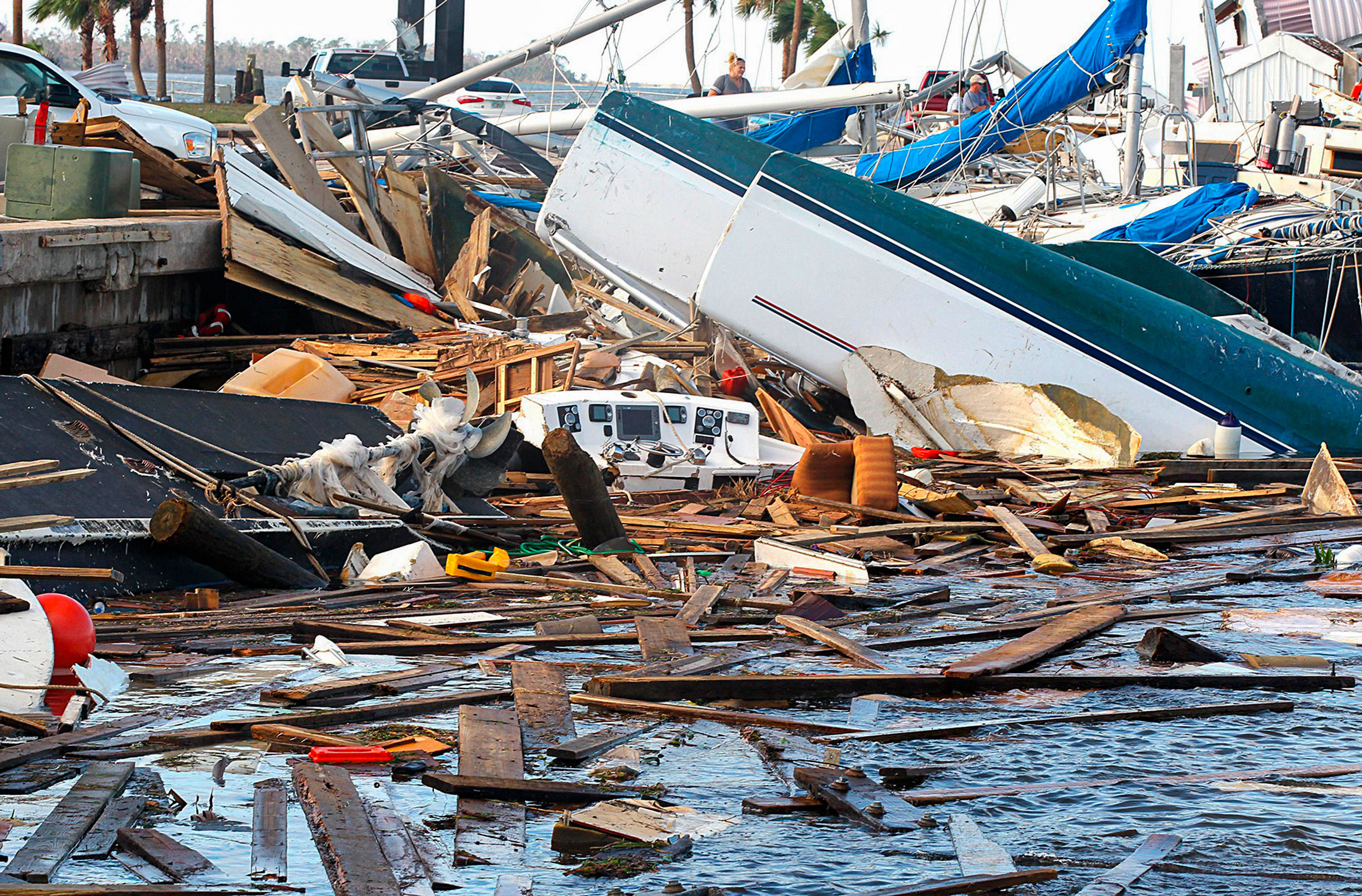
Storms routinely damage and destroy boats, leading to the abandonment of many fiberglass hulls in the marine environment. Photo by Pedro Portal/Miami Herald/TNS/Alamy Live News
Marine ecologist Simon Bray wrote the 2019 IMO report. Bray, codirector of Aqass, a UK environmental research company based only 60 kilometers west of Chichester Harbour, says alarm is growing over the environmental impact of fiberglass boats across the planet. “The initial demand for the [IMO] study came from small island states in the Pacific who were having issues with owners abandoning boats at remote islands,” he writes in an email.
In North America, people like John Roe are also raising the alarm. Cofounder of the Dead Boats Disposal Society based in Victoria, British Columbia, Roe sees the same impact of abandoned boats as on England’s south coast. The dead boats don’t retain their structure once submerged, and then they break up, ending up in our food chain, Roe writes in an email. In 2022, the society estimated there were at least 2,400 problematic abandoned boats in British Columbia alone.
Roe offers a scathing view of the situation in Canada, including a cynical opinion of the government’s much-vaunted Oceans Protection Plan (OPP), introduced in 2016 with the aim of improving marine safety and responsible boating and shipping to protect Canada’s marine environment. Roe and other critics see a gap between rhetoric and practical action.
In one example, the small community on Parker Island, off the BC coast, spent 10 years trying in vain to get authorities to deal with a derelict commercial vessel abandoned on their shoreline. They found multiple agencies keen only to pass the buck, shunting complainants endlessly between different departments including navigation, the environment, land management, and coast guard. For Roe, this spotlights a deep flaw in the OPP caused by a lack of integration between multiple agencies. Other critics have highlighted issues around funding not being distributed properly, as well as a failure to include inland waters.

Most jurisdictions lack policies to deal with derelict and abandoned boats. Photo by Yau Ming Low/Alamy Stock Photo
Back in the United Kingdom, Bray offers a similarly jaded view of international legislation, highlighting failings in three key conventions adopted in the 1970s and 1990s. The London Convention and London Protocol are global agreements to protect the marine environment. The third is the International Convention for the Prevention of Pollution from Ships (MARPOL), the main international agreement to prevent pollution of the marine environment by boats and ships.
MARPOL makes it illegal to discharge plastic at sea, but fiberglass hulls are not covered, as MARPOL is pertinent to ship-borne garbage, Bray points out. And, he adds, the London Convention and London Protocol do not explicitly address pollution caused by fiberglass vessels or abandoned boats.
The best route for tackling the damage from abandoned boats, Roe says, is pinning greater responsibility on boat owners for responsible disposal, as well as on the wider leisure boat industry to help by providing more ecological ways to both maintain boats and dispose of them at the end of their life. He also wants proper ownership records and clear licensing of pleasure vessels, perhaps a plating system or identification marks stamped on hulls, along with insurance with end-of-life requirements. Roe also suggests something along the lines of amnesty, a “turn in your boat day.”
In the United States, California has been proactive. The state is funding two programs: the no-cost Vessel Turn-In Program for recreational boat owners to surrender unwanted boats, and the Surrendered and Abandoned Vessel Exchange for removal of abandoned vessels. Owners caught in the act of abandoning a vessel can be fined up to US $3,000, plus the considerable costs of removal and disposal.
Elsewhere in the United States, Maryland has created a compulsory registration system for boats used in the state and has also instituted an Abandoned Boat and Debris Program funded by a five percent tax paid when a boat is purchased and titled in the state. “Though that only sees the boats go to landfill,” Ciocan says, merely shifting the damaging environmental impact of fiberglass from the ocean to soils. It’s an issue, she says, that is also set to prompt difficult debate in the green energy industry with the disposal of the giant fiberglass blades used in wind turbines. These typically reach the end of their working life after about 25 years, and without any established recycling route, are currently being dumped in landfills by the thousands across the planet.
Across the Atlantic, France introduced a scheme in 2019 under the aegis of APER, a nonprofit organization set up in 2009 by the French Nautical Industries Federation to encourage more environmental responsibility in the boating industry. This includes requiring buyers to officially register a new vessel, as well as pay an eco-tax designed to create funds for disposing of end-of-life boats at dismantling centers around France. According to APER, an estimated 13,000 leisure boats are expected to reach end-of-life in France each year.
Perhaps the answer is an outright ban on fiberglass boats, the same kind of international legislation that led to the ban on the chlorofluorocarbon gases that punched a hole in Earth’s ozone layer. But given the vast size of the pleasure craft fleet, Bray sees transition to a more suitable material as more feasible. Roe agrees—he believes the science needs to change on how plastics are made.
Science still has a long way to go but a return to organic materials is possible. In fact, cotton was used as a key complement in early plastics, since it provides excellent mechanical reinforcement, and flax fibers were integral to the first composite aircraft structures. Hemp and coconut are other plant fibers that offer a mix of workability plus structural and mechanical qualities that could underpin recycling-friendly composites. They have potential, says Bray, although he cautions about the need to avoid “armies of related plantations further degrading natural habitat to supply the industry.”
In Germany, the technology company Greenboats is pioneering composites made from flax fibers and bio-based resins. Unlike the emission-heavy petrochemical processes behind fiberglass, flax absorbs carbon dioxide as it grows, and the manufacture of flax-based composites uses around 20 percent of the energy of fiberglass production, according to Jan Paul Schirmer, managing director of Greenboats. He also calls for a maritime equivalent to car-share programs on land: like terrestrial traffic, it would lead to fewer boats on the water.

A Germany company is using flax-based resin as a substitute for fiberglass. Photo courtesy of Greenboats
Basalt fiber is another boatbuilding material offering a less environmentally damaging alternative to fiberglass. Made by crushing volcanic rock, heating it intensely, then extruding the mash through tiny nozzles to form structural fibers, basalt fiber is stronger than steel, inert in terms of reacting with air or water, and only two to five percent heavier than different forms of fiberglass. It is also comparable in price.
But more is needed beyond material advances. “At the end of the day, everything is driven by money,” says Ciocan, who points out that the fiberglass leisure boat market is predicted to continue growing over the coming years.
Yet with Ciocan and other researchers spotlighting the ubiquitous problem of fiberglass boat pollution—whether from active or abandoned boats—some sense of real change is finally coming. As well as boats made from new materials taking to the water around the world and more rigorous legislation on ownership and boat disposal, there is the work underway in Ciocan’s lab to trial new materials designed to actively remove fiberglass pollution from sites like Chichester Harbour. One of her graduate students has developed a new biocomposite material that absorbs microplastics from water in laboratory testing and is now being readied for real-world use at different sites around Chichester Harbour.
All of which means hope for us, and for the oysters.
Correction: The story has been updated to reflect that both fiberglass and metal boat hulls release microplastics into the water from paint.

